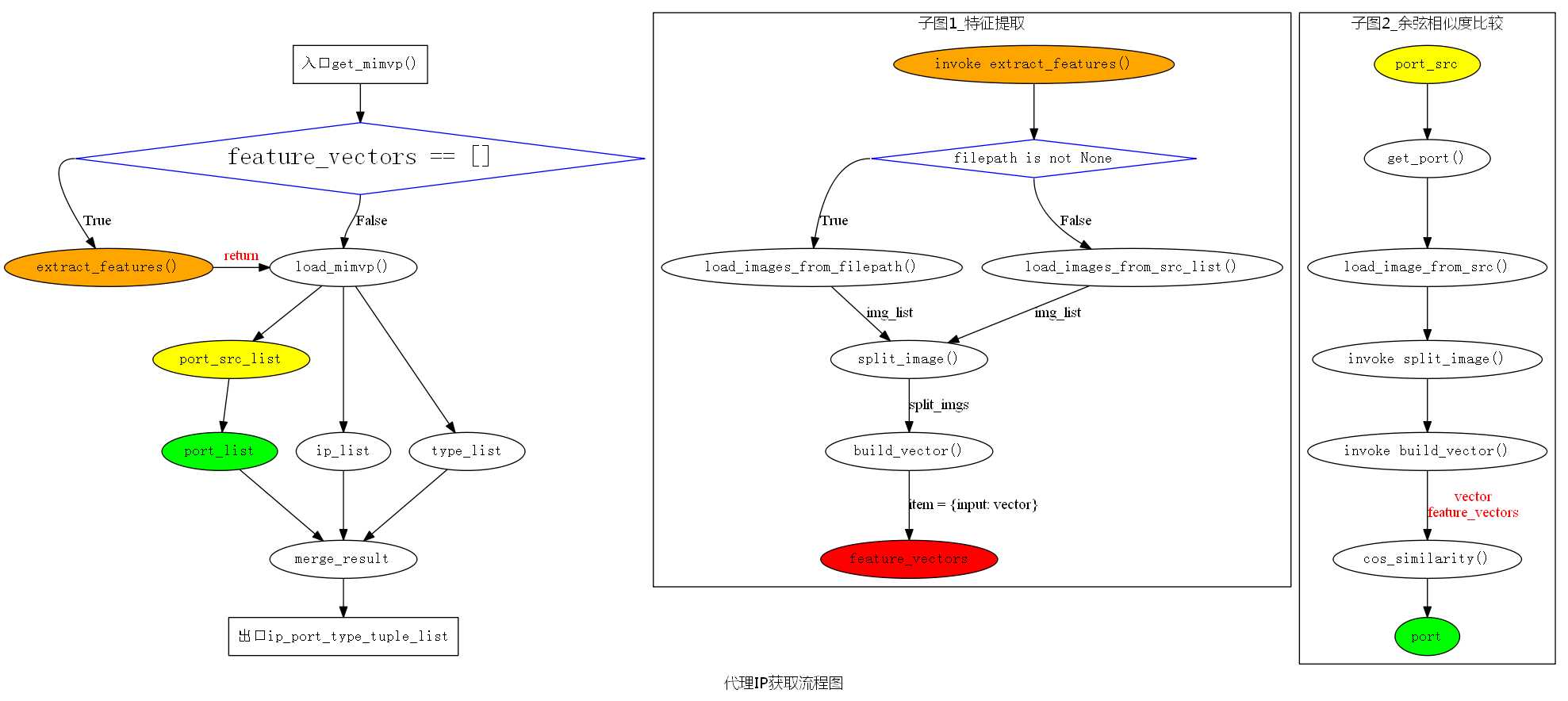标签:数字 blog val isp one bre 二维 header i+1
1.参考
2.没事画个流程图
3.完整代码
4.改进方向
https://en.wikipedia.org/wiki/Cosine_similarity
https://zh.wikipedia.org/wiki/%E4%BD%99%E5%BC%A6%E7%9B%B8%E4%BC%BC%E6%80%A7
Cosine similarity
Given two vectors of attributes, A and B, the cosine similarity, cos(θ),
is represented using a dot product and magnitude as...
余弦相似性通过测量两个向量的夹角的余弦值来度量它们之间的相似性。0度角的余弦值是1,
余弦相似度通常用于正空间,因此给出的值为0到1之间。
范数(norm),是具有“长度”概念的函数。二维度的向量的欧氏范数就是箭号的长度。

这两篇文章在计算矢量大小的时候函数参数都写成 concordance调和, 而不用 coordinate坐标, 为何???
numpy中提供了范数的计算工具:linalg.norm()
所以计算cosθ起来非常方便(假定A、B均为列向量):
num = float(A.T * B) #若为行向量则 A * B.T denom = linalg.norm(A) * linalg.norm(B) cos = num / denom #余弦值
流程图 Graphviz - Graph Visualization Software


#!/usr/bin/env python # -*- coding: UTF-8 -* import os import time import re from urlparse import urljoin import requests ss = requests.Session() ss.headers.update({‘user-agent‘:‘Mozilla/5.0 (Windows NT 6.1; WOW64; rv:54.0) Gecko/20100101 Firefox/54.0‘}) from PIL import Image # https://www.liaoxuefeng.com/wiki/0014316089557264a6b348958f449949df42a6d3a2e542c000/001431918785710e86a1a120ce04925bae155012c7fc71e000 # 和StringIO类似,可以用一个bytes初始化BytesIO,然后,像读文件一样读取: from io import BytesIO from string import ascii_letters, digits import numpy as np # ip_port_type_tuple_list = [] class Mimvp(): def __init__(self, num_width=None, feature_vectors=None, white_before_black=2, threshhold=100, max_nums=None, filepath=None, page=None): self.ip_port_type_tuple_list = [] #fluent p189 if feature_vectors is None: self.feature_vectors = [] else: self.feature_vectors = list(feature_vectors) self.num_width = num_width self.white_before_black = white_before_black self.threshhold = threshhold self.max_nums = max_nums self.filepath = filepath if page is None: self.url = ‘http://proxy.%s.com/free.php?proxy=in_hp‘%‘mimvp‘ else: self.url = ‘http://proxy.%s.com/free.php?proxy=in_hp&sort=&page=%s‘ %(‘mimvp‘, page) def get_mimvp(self): # 预处理提取特征组需要取得 self.port_src_list if self.feature_vectors == []: self.extract_features() self.load_mimvp() self.get_port_list() self.merge_result() return self.ip_port_type_tuple_list def load_mimvp(self): resp = ss.get(self.url) self.ip_list = re.findall(r"class=‘tbl-proxy-ip‘.*?>(.*?)<", resp.text) self.port_src_list = re.findall(r"class=‘tbl-proxy-port‘.*?src=(.*?)\s*/>", resp.text) #图片链接 self.type_list = re.findall(r"class=‘tbl-proxy-type‘.*?>(.*?)<", resp.text) def get_port_list(self): self.port_list = [] for src in self.port_src_list: port = self.get_port(src) self.port_list.append(port) def get_port(self, src): img = self.load_image_from_src(src) split_imgs = self.split_image(img) port = ‘‘ for split_img in split_imgs: vector = self.build_vector(split_img) compare_results = [] for t in self.feature_vectors: cos = self.cos_similarity(vector, t.values()[0]) compare_results.append((cos, t.keys()[0])) # print sorted(compare_results, reverse=True) port += sorted(compare_results, reverse=True)[0][1] print port return port def load_image_from_src(self, src): src = urljoin(self.url, src) print src, resp = ss.get(src) fp = BytesIO(resp.content) img = Image.open(fp) return img def split_image(self, img): gray = img.convert(‘L‘) if self.num_width is None: img.show() print gray.getcolors() self.num_width = int(raw_input(‘num_width:‘)) self.white_before_black = int(raw_input(‘white_before_black:‘)) self.threshhold = int(raw_input(‘BLACK < (threshhold) < WHITE:‘)) gray_array = np.array(gray) bilevel_array = np.where(gray_array<self.threshhold,1,0) #标记黑点为1,方便后续扫描 left_list = [] # 从左到右按列求和 vertical = bilevel_array.sum(0) # print vertical # 从左到右按列扫描,2白1黑确定为数字左边缘 for i,c in enumerate(vertical[:-self.white_before_black]): if self.white_before_black == 1: if vertical[i] == 0 and vertical[i+1] != 0: left_list.append(i+1) else: if vertical[i] == 0 and vertical[i+1] == 0 and vertical[i+2] != 0: left_list.append(i+2) if len(left_list) == self.max_nums: break # 分割可见图片 # bilevel = Image.fromarray(bilevel_array) #0/1 手工提取特征 show显示黑块 还没保存gif bilevel = Image.fromarray(np.where(gray_array<self.threshhold,0,255)) # the left, upper, right, and lower pixel split_imgs = [bilevel.crop((each_left, 0, each_left+self.num_width, img.height)) for each_left in left_list] return split_imgs def build_vector(self, img): # img = Image.open(img) img_array = np.array(img) # 先遍历w,再遍历h,总共w+h维度,不需要/255,标记黑点个数等多余处理 return list(img_array.sum(0)) + list(img_array.sum(1)) def cos_similarity(self, a, b): A = np.array(a) B = np.array(b) dot_product = float(np.dot(A, B)) # A*(B.T) 达不到目的 magnitude_product = np.linalg.norm(A) * np.linalg.norm(B) cos = dot_product / magnitude_product return cos def merge_result(self): for ip, port, _type in zip(self.ip_list, self.port_list, self.type_list): if ‘/‘ in _type: self.ip_port_type_tuple_list.append((ip, port, ‘both‘)) elif _type == ‘HTTPS‘: self.ip_port_type_tuple_list.append((ip, port, ‘HTTPS‘)) else: self.ip_port_type_tuple_list.append((ip, port, ‘HTTP‘)) def extract_features(self): if self.filepath is not None: img_list = self.load_images_from_filepath() else: self.load_mimvp() img_list = self.load_images_from_src_list() for img in img_list: split_imgs = self.split_image(img) for split_img in split_imgs: split_img.show() print split_img.getcolors() input = raw_input(‘input:‘) vector = self.build_vector(split_img) item = {input: vector} if item not in self.feature_vectors: print item self.feature_vectors.append(item) for i in sorted(self.feature_vectors): print i,‘,‘ def load_images_from_filepath(self): img_list = [] postfix = [‘jpg‘, ‘png‘, ‘gif‘, ‘bmp‘] for filename in [i for i in os.listdir(self.filepath) if i[-3:] in postfix]: file = os.path.join(self.filepath, filename) img_list.append(Image.open(file)) return img_list def load_images_from_src_list(self): img_list = [] for src in self.port_src_list: img = self.load_image_from_src(src) img_list.append(img) return img_list if __name__ == ‘__main__‘: feature_vectors = [ {‘0‘: [4845, 5865, 5865, 5865, 5865, 4845, 1530, 1530, 1530, 1530, 1530, 1530, 1530, 1530, 1020, 1020, 1020, 1020, 1020, 1020, 1020, 1020, 1020, 1020, 1530, 1530, 1530, 1530, 1530, 1530, 1530]} , {‘1‘: [5865, 5865, 3825, 6120, 6120, 6375, 1530, 1530, 1530, 1530, 1530, 1530, 1530, 1530, 1275, 1020, 1020, 1275, 1275, 1275, 1275, 1275, 1275, 255, 1530, 1530, 1530, 1530, 1530, 1530, 1530]} , {‘2‘: [5100, 5610, 5610, 5610, 5610, 5355, 1530, 1530, 1530, 1530, 1530, 1530, 1530, 1530, 510, 1020, 1020, 1275, 1020, 1275, 1275, 1275, 1275, 0, 1530, 1530, 1530, 1530, 1530, 1530, 1530]} , {‘3‘: [5355, 5865, 5610, 5610, 5610, 4590, 1530, 1530, 1530, 1530, 1530, 1530, 1530, 1530, 510, 1020, 1020, 1275, 765, 1275, 1275, 1020, 1020, 510, 1530, 1530, 1530, 1530, 1530, 1530, 1530]} , {‘4‘: [5610, 5865, 5865, 5865, 3825, 6120, 1530, 1530, 1530, 1530, 1530, 1530, 1530, 1530, 1275, 1020, 1020, 1020, 1020, 1020, 0, 1275, 1275, 1275, 1530, 1530, 1530, 1530, 1530, 1530, 1530]} , {‘5‘: [4845, 5610, 5610, 5610, 5610, 5100, 1530, 1530, 1530, 1530, 1530, 1530, 1530, 1530, 0, 1275, 1275, 1275, 255, 1275, 1275, 1275, 1020, 510, 1530, 1530, 1530, 1530, 1530, 1530, 1530]} , {‘6‘: [4590, 5610, 5610, 5610, 5610, 5355, 1530, 1530, 1530, 1530, 1530, 1530, 1530, 1530, 765, 1275, 1275, 1275, 255, 1020, 1020, 1020, 1020, 510, 1530, 1530, 1530, 1530, 1530, 1530, 1530]} , {‘7‘: [6120, 6120, 6120, 5100, 5355, 5610, 1530, 1530, 1530, 1530, 1530, 1530, 1530, 1530, 0, 1275, 1275, 1275, 1275, 1275, 1275, 1275, 1275, 1275, 1530, 1530, 1530, 1530, 1530, 1530, 1530]} , {‘8‘: [4590, 5610, 5610, 5610, 5610, 4590, 1530, 1530, 1530, 1530, 1530, 1530, 1530, 1530, 510, 1020, 1020, 1020, 510, 1020, 1020, 1020, 1020, 510, 1530, 1530, 1530, 1530, 1530, 1530, 1530]} , {‘9‘: [5610, 5610, 5610, 5610, 5610, 4590, 1530, 1530, 1530, 1530, 1530, 1530, 1530, 1530, 510, 1020, 1020, 1020, 255, 1275, 1275, 1275, 1275, 765, 1530, 1530, 1530, 1530, 1530, 1530, 1530]} , ] # def __init__(self, feature_vectors=None, filepath=None, page=None): obj = Mimvp(num_width=6, feature_vectors=feature_vectors) # obj = Mimvp() # obj = Mimvp(filepath=‘temp/‘) ip_port_type_tuple_list = obj.get_mimvp() from pprint import pprint pprint(ip_port_type_tuple_list)
记录每个分割数字的x轴实际长度,这样的话考虑到不对图片的上下留白做处理,每个实际数字的h固定,而w不定,因此建立特征向量的时候改为先遍历h,再遍历w。
考虑到在比较余弦相似性的时候由于叉乘需要两个向量具有相同的维度,这里需要每次取最小维度再比较。
如此,在建立特征向量集的时候不需要提前指定每张分割数字为固定宽度。
标签:数字 blog val isp one bre 二维 header i+1
原文地址:http://www.cnblogs.com/my8100/p/7449845.html